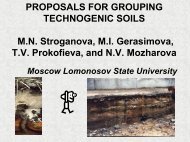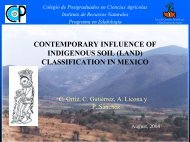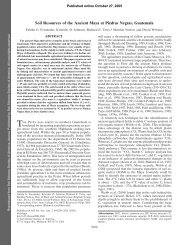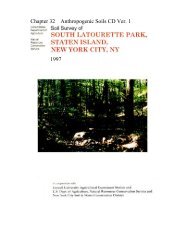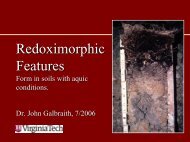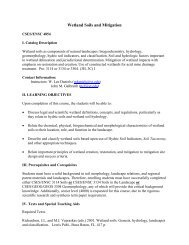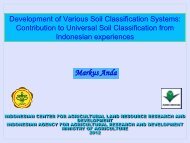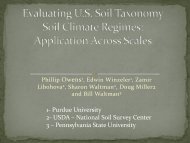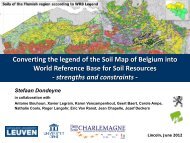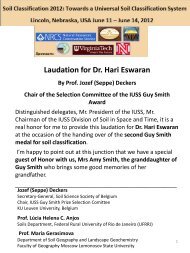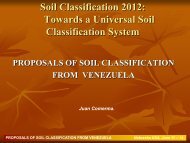Nebraska Soils Field Trip - Virginia Tech
Nebraska Soils Field Trip - Virginia Tech
Nebraska Soils Field Trip - Virginia Tech
You also want an ePaper? Increase the reach of your titles
YUMPU automatically turns print PDFs into web optimized ePapers that Google loves.
4th IUSS Soil Classification Conference <strong>Field</strong> Tour Guidebook<br />
brown (10YR 8/2) masses of carbonate; few fine and medium very pale brown (10YR 8/2)<br />
carbonate concretions; few fine distinct grayish brown (2.5Y 5/2) redoximorphic depletions and<br />
few fine prominent strong brown (7.5YR 5/6) redoximorphic concentrations; strongly<br />
effervescent; moderately alkaline; clear smooth boundary. [Combined thickness of the Bk<br />
horizons is 20 to 97 centimeters (8 to 38 inches).]<br />
C1--97 to 140 centimeters (38 to 55 inches); brown (10YR 5/3) clay loam; massive; firm;<br />
common very fine roots; common very fine and fine tubular pores; common fine and medium<br />
very pale brown (10YR 8/2) masses of carbonate; common fine and medium very pale brown<br />
(10YR 8/2) carbonate concretions; common fine and medium distinct strong brown (7.5YR 4/6)<br />
redoximorphic concentrations; strongly effervescent; moderately alkaline; gradual smooth<br />
boundary.<br />
C2--140 to 170 centimeters (55 to 67 inches); about 50 percent strong brown (7.5YR 5/6) and<br />
about 50 percent grayish brown (2.5Y 5/2) clay loam; massive; firm; common very fine and fine<br />
tubular pores; common fine and medium very pale brown (10YR 8/2) masses of carbonate; few<br />
fine and medium very pale brown (10YR 8/2) carbonate concretions; few distinct very dark<br />
brown (7.5YR 2/2) manganese stains on faces of peds and in pores; strongly effervescent;<br />
moderately alkaline; gradual smooth boundary.<br />
C3--170 to 203 centimeters (67 to 80 inches); about 50 percent strong brown (7.5YR 5/6) and<br />
about 50 percent gray (2.5Y 6/1) clay loam; massive; firm; common very fine and fine tubular<br />
pores; common fine and medium very pale brown (10YR 8/2) masses of carbonate; few fine and<br />
medium very pale brown (10YR 8/2) carbonate concretions; few distinct very dark brown<br />
(7.5YR 2/2) manganese stains on faces of peds and in pores; strongly effervescent; moderately<br />
alkaline.<br />
TYPE LOCATION: MLRA 107B-Iowa and Missouri Deep Loess Hills, Crawford County,<br />
Iowa subset; about 9.5 miles northeast of Dennison; about 840 feet north and 1,410 feet west of<br />
the southeast corner of sec. 28, T. 85 N., R. 38 W.; USGS Kiron quadrangle; lat. 42 degrees 8<br />
minutes 29.4 seconds N. and long. 95 degrees 16 minutes 8.9 seconds W., NAD 83<br />
RANGE IN CHARACTERISTICS:<br />
Depth to carbonates--0 to 25 centimeters (0 to 10 inches)<br />
Content of clay in the particle-size control section (weighted average)--27 to 35 percent<br />
Content of sand in the particle-size control section (weighted average)--25 to 45 percent<br />
A or Ap horizon:<br />
Hue--10YR<br />
Value--2 or 3<br />
Chroma--1 or 2<br />
Texture--loam or clay loam<br />
Clay content--24 to 35 percent<br />
Sand content--30 to 52 percent<br />
Rock fragment content--1 to 5 percent<br />
Calcium carbonate equivalent--5 to 10 percent<br />
180



